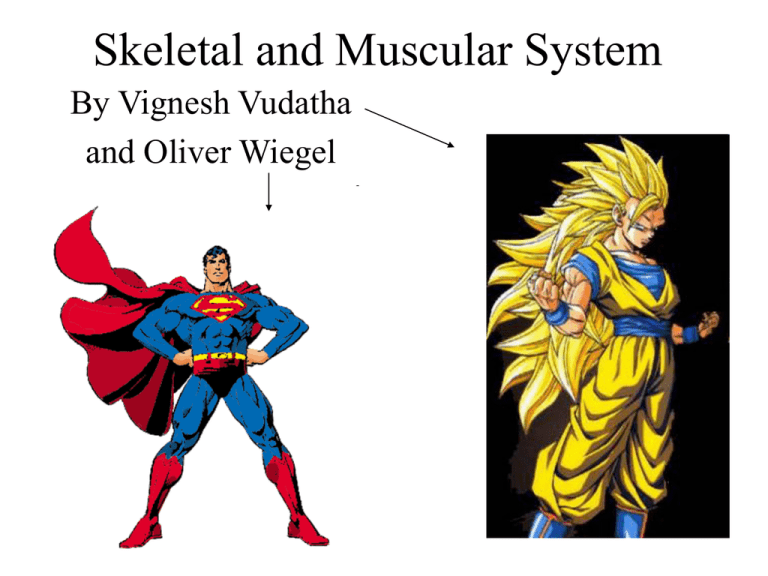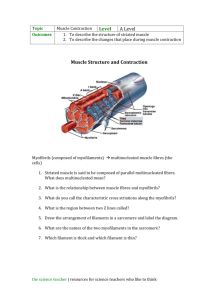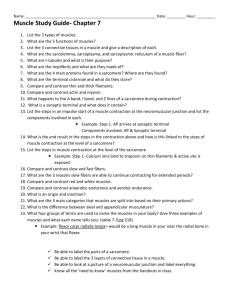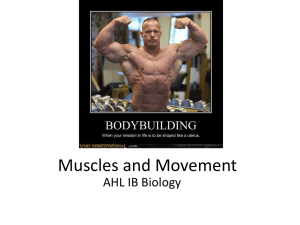Skeletal and Muscular System
advertisement

Skeletal and Muscular System By Vignesh Vudatha and Oliver Wiegel • Motion is caused by the various forms of sensory inputs to the nervous system. • These inputs cause muscles to work against the skeleton to facilitate movement of the body. • What are the functions of a skeleton? Support Protection Movement Types of Skeletons Hydrostatic skeletons: fluid is held together under pressure in compartments, whose form can be altered for movement Examples include flatworms, nematodes, and cnidarians such as this hydra Movement terminology • Muscles: provide the force needed for muscle contraction • Tendons: attach muscles to bones • Bones: provide a firm anchorage for muscles. They also act as levers, changing the size or direction of forces generated by muscles • Ligaments: connect bone to bone, restricting movement at joints and helping to prevent dislocation • Nerves: stimulate muscles to contract at a precise time and extent, so that movement is coordinated IB standard Hydrostatic Skeletons con. Organisms such as annelids, that have hydrostatic skeletons, display peristaltic behavior. Through peristalsis, muscles contract rhythmically, allowing for forward movement. Types of Skeleton: Exoskeleton •A hard layer surrounding the epidermis of animals •A key characteristic of arthropods •Expands as animal grows •For arthropods, their jointed exoskeleton is called a cuticle •A major component is chitin, a polysaccharide that hardens the cuticle Cuticle is hardened with organic compounds when protection is necessary Type of Skeleton: Endoskeleton •Tough elements within soft tissues •Sponges, echinoderms, humans •Mammals have skeletons of more than 200 bones, some of which are fused and others connected by ligaments. (How many do we have?) •The human skeleton is designed (evolution…) such that the legs are positioned under the body, bearing most of the body weight. •Muscles and tendons keep legs relatively straight and provide movement in the skeletal system. •Muscles only contract. After contraction, muscles relax passively Ex. Elbow joint Joints • Cartilage: reduces friction between bones where they meet • Synovial fluid: lubricates the joint to reduce friction • Joint capsule: seals the joint and holds in the synovial fluid. IB standard Biceps bend the arm at the elbow and triceps straighten the arm These muscles are antagonistic because they oppose each other’s motion radius Radius transmits forces from biceps, and ulna transmits forces from triceps Humerus: anchorage for muscles IB wants you to know how to label diagram ulna Hip vs. Knee Joints: IB wants you to know this Move your knee, it’s like a hinge. It only moves along one plane. (You can try the other planes of motion if you want) The knee exhibits a bending (flexion) or straightening (extension) effect. Stand up and move your hip in any way you want. This is possible because the hip can move in all three planes (the technical terms are protraction/retraction, abduction/adduction, and rotation The elbow joint in the previous example is like the knee, it’s a hinge with only one plane of motion Skeletal Muscle terminology •Skeletal Muscle: attached to bones and is responsible for movement. They consist of bundles of long fibers, which are cells with multiple nuclei. •Fibers themselves are made up of myofibrils, which are composed of myofilaments (thin and thick). Thin ones consist of two strands of actin and one strand of protein, while thick ones are arrays of myosin molecules IB standard • Muscle cells have multiple nuclei and thousands of mitochondria • Sarcoplasmic reticulum encompasses individual fibers http://fitnessratchet.com/images/musclefiber.jpeg Muscle Structure and Basic Characteristics of Contraction Skeletal Muscle is striated, meaning it is arranged to create a pattern of light and dark bands. Each unit is called a sarcomere. Sarcomeres contain Z lines, I bands, A bands, H bands, and thick (myosin) and thin (actin) filaments IB standard The top one is a relaxed muscle, while the bottom one is a contracted muscle cell. The easy way to distinguish is to notice the width of the sarcomere. In the relaxed muscle, the sarcomere is wide, while in the contracted muscle, the sarcomere is contracted (easy to remember) IB standard Muscle Motion • Sliding-filament model: neither thin filaments nor thick filaments change in length; thin filaments only slide past each other further to contract the muscle • Contraction is when these filaments are moved together. Hence in the micrograph, the sacromeres look to be fatter, since the fibers are overlapping each other • ATP is bound and hydrolyzed to ADP by individual myosin molecule in a thick filament • This triggers the binding of a myosin (thick filament) to an actin (thin filament) http://physioweb.med.uvm.edu/muscle_physio/muscle_contraction • The thick filament makes several of these connections at once to a thin filament. • Each individual actin-myosin bond will last until a new ATP molecule severs it and binds to a myosin head. The ATP molecule will be broken, and the myosin will connect to another actin molecule. • Because a single myosin head forms about five of these bonds per second, and there are ~350 heads on a thick filament, the thin filaments “slide” to contract rather rapidly • To keep them passive, thick muscle filaments’ myosin heads are usually blocked by an allosteric regulator protein called tropomyosin. • Tropomyosin is rearranged in position by a rising concentration of Calcium ions from the sarcoplasmic reticulum, which bind to the troponin complex, which regulates where tropomyosin is on the thick filament. • This allows the heads of myosin to be exposed and contraction can take place. • Motor neurons control the contraction of muscles. • All contractions begin with a twitch lasting less than 1/10 of a second, with more twitches added on to increase tension • Eventually, these twitches add up in the tension they produce and then are expanded into a smooth contraction (the kind you’re used to feeling) called a tetanus Muscle Contraction Listen carefully http://media.pearsoncmg.com/bc/bc_campbell_biology_6/cipl/ins/4 9/HTML/source/71.html








